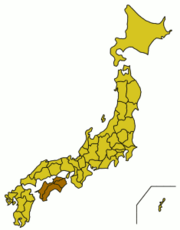Shikoku
| Native name: 四国 | |
 The island of Shikoku, Japan |
|
| Geography | |
|---|---|
| Location | East Asia |
| Archipelago | Japanese Archipelago |
| Area | 18,800 km2 (7,259 sq mi) (50th) |
| Highest point | Mount Ishizuchi (1,982 m (6,503 ft)) |
| Country | |
| Prefectures | Ehime, Kagawa, Kochi, Tokushima |
| Largest city | Matsuyama (512,982) |
| Demographics | |
| Population | 4,141,955 (as of 2005) |
| Density | 220.32 people/km2 |
| Ethnic groups | Japanese |
Shikoku (四国? "four provinces") is the smallest (225 km long and between 50 and 150 km wide) and least populous (4,141,955 as of 2005) of the four main islands of Japan, located south of Honshū and east of Kyūshū island. Its ancient names include Iyo-no-futana-shima (伊予之二名島), Iyo-shima (伊予島), and Futana-shima (二名島). The current name refers to the four former provinces which made up the island: Awa, Tosa, Sanuki, and Iyo.
Contents |
Geography
The Shikoku region, comprising Shikoku and its surrounding islets, covers about 18,800 square kilometres (7,259 sq mi) and consists of four prefectures: Ehime, Kagawa, Kochi, and Tokushima. Across the Inland Sea lie Wakayama, Osaka, Hyōgo, Okayama, Hiroshima, and Yamaguchi Prefectures on Honshū. To the west lie Ōita and Miyazaki Prefectures on Kyūshū.
The 50th largest island by area, Shikoku is smaller than Sardinia and Bananal, but larger than Halmahera and Seram. By population, it ranks 23rd, having fewer inhabitants than Sicily or Singapore, but more than Puerto Rico or Negros.
Mountains running east and west divide Shikoku into a narrow northern subregion, fronting on the Inland Sea, and a southern part facing the Pacific Ocean. Most of the 4.5 million inhabitants live in the north, and all but one of the island's few larger cites are located there. Mount Ishizuchi (石鎚山) in Ehime at 1,982 m (6,503 ft) is the highest mountain on the island. Industry is moderately well developed and includes the processing of ores from the important Besshi copper mine. Land is used intensively. Wide alluvial areas, especially in the eastern part of the zone, are planted with rice and subsequently are double cropped with winter wheat and barley. Fruit is grown throughout the northern area in great variety, including citrus fruits, persimmons, peaches, and grapes. Because of wheat production Sanuki udon (讃岐うどん) became an important part of the diet in Kagawa Prefecture (former Sanuki Province) in the Edo period.

The larger southern area of Shikoku is mountainous and sparsely populated. The only significant lowland is a small alluvial plain at Kōchi, the prefectural capital. The area's mild winters stimulated some truck farming, specializing in growing out-of-season vegetables under plastic covering. Two crops of rice can be cultivated annually in the southern area. The pulp and paper industry took advantage of the abundant forests and hydroelectric power.
Shikoku has four important capes. Gamōda in Anan, Tokushima is the easternmost point on the island, and Sada in Ikata, Ehime the westernmost. Muroto in Muroto, Kochi and Ashizuri, the southern extreme of Shikoku, in Tosashimizu, Kochi, jut into the Pacific Ocean. The island's northernmost point is in Takamatsu, Kagawa.
Transportation
Shikoku is connected to Honshū by three expressways.
- Kobe-Awaji-Naruto Expressway (Eastern Shikoku)
- Seto-Chūō Expressway (Central Shikoku)
- Nishiseto Expressway (Western Shikoku)
The eastern gateway to Shikoku, Naruto City in Tokushima Prefecture has been linked to the Kobe-Awaji-Naruto Expressway since 1998. This line connects Shikoku to the Kansai area which has a large population, including the large conurbations of Osaka, Kyoto and Kobe. Therefore, the Kobe-Awaji-Naruto Expressway carries a large traffic volume. Many highway buses are operated between Kansai and Tokushima Prefecture.
The central part of Shikoku is connected to Honshū by ferry, air and since 1988, by the Great Seto Bridge network. Until completion of the bridges, the region was isolated from the rest of Japan. The freer movement between Honshū and Shikoku was expected to promote economic development on both sides of the bridges, which has not materialized yet.
Within the island, a web of national highways connects the major population centers. These include Routes 11, 32, 33, 55, and 56.
The Shikoku Railway Company (JR Shikoku) serves the island. JR lines include:
- Yosan Line
- Dosan Line
- Kōtoku Line
- Tokushima Line
- Mugi Line
- Naruto Line
- Uchiko Line
- Yodo Line
- Honshi Bisan Line
- Seto Ōhashi Line
Private railway lines operate in each of the four prefectures on Shikoku.
Shikoku lacks a full international airport but has 4 regional airports (Tokushima, Takamatsu, Kochi-Ryoma and Matsuyama Airport). All of these airports have flights to Tokyo and other major Japanese cities such as Osaka, Nagoya, Sapporo, and Fukuoka. International flights to Seoul, South Korea are serviced by Asiana Airlines from Matsuyama and Takamatsu. There are periodic international charter flights as well.
Ferries link Shikoku to destinations including Kyūshū and islands around Shikoku.
Movements
Pioneering organic farmer Masanobu Fukuoka, author of The One-Straw Revolution, developed his methods here on his family's farm.
Traditions
Shikoku is also famous for its 88-temple pilgrimage of temples associated with the priest Kūkai. Most modern day pilgrims travel by bus, rarely choosing the old-fashioned method of going by foot. They are seen wearing white jackets emblazoned with the characters reading dōgyō ninin meaning "two traveling together".
Tokushima Prefecture also has its annual Awa Odori running in August at the time of the Obon festival, which attracts thousands of tourists each year from all over Japan and from abroad.
References
- This article contains material from the Library of Congress Country Studies, which are United States government publications in the public domain. - Japan
See also
- Geography of Japan
- Regions of Japan
External links
|
|||||||||||